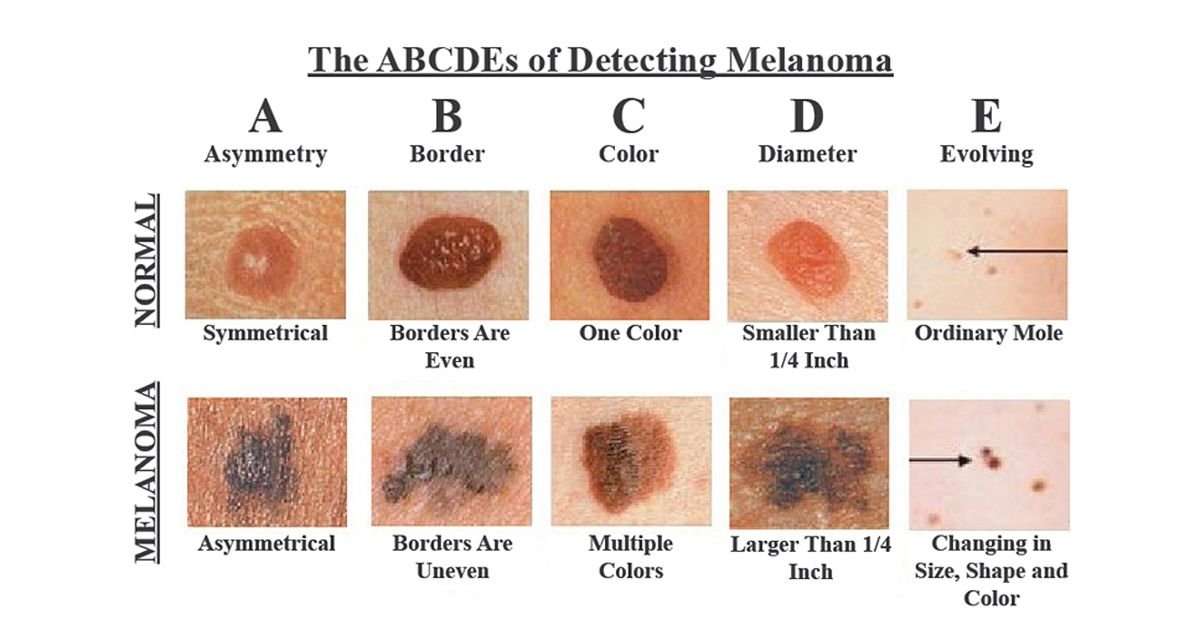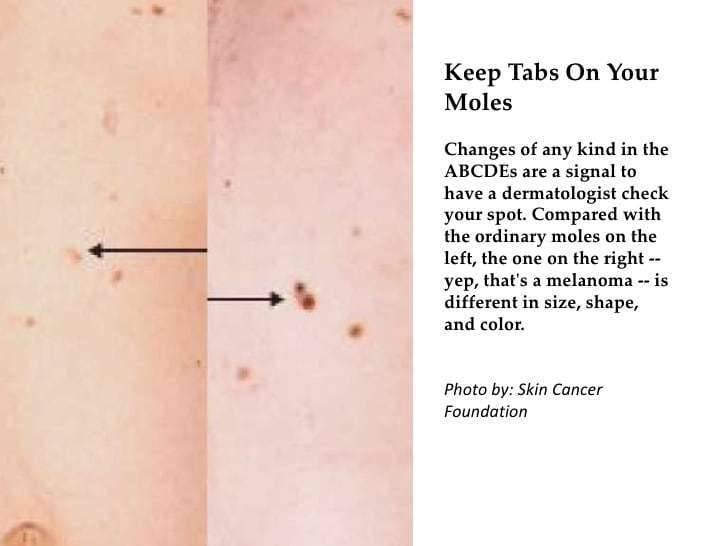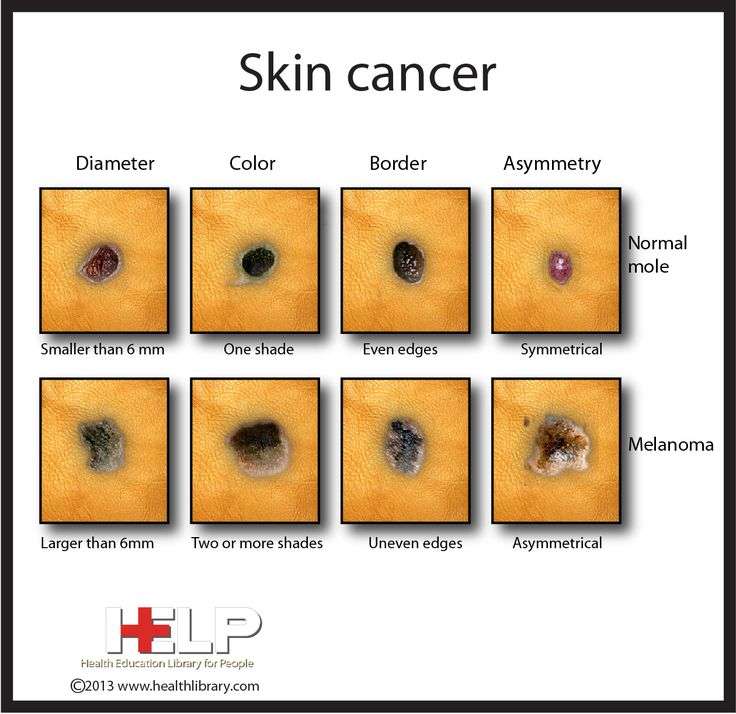E: Evolving And/or Elevated
“E” stands for two different features of melanoma:
- Elevation: Moles are often elevated above the skin, often unevenly so with some parts raised and others flat.
- Evolving: A mole that is evolving is also concerning and, in retrospect, many people with melanomas note that a mole had been changing in terms of size, shape, color, or general appearance before they were diagnosed.
When a melanoma develops in an existing mole, the texture may change and become hard, lumpy, or scaly. Although the skin may feel different and itch, ooze, or bleed, a melanoma does not usually cause pain.
How Are Moles Evaluated
If you find a mole or spot that has any ABCDE’s of melanoma — or one that’s tender, itching, oozing, scaly, doesn’t heal or has redness or swelling beyond the mole — see a doctor. Your doctor may want to remove a tissue sample from the mole and biopsy it. If found to be cancerous, the entire mole and a rim of normal skin around it will be removed and the wound stitched closed. Additional treatment may be needed.
How To Identify Skin Cancer Vs Age Spots
Finding a strange spot on your body can be pretty scary. You dont know how long it will be there, if its dangerous, or what it even is. The best thing you can do when you find weird-looking spot on your body is to visit your dermatologist.
While youre waiting to see a doctor, you may want to better understand two common types of skin spots: skin cancer and age spots, also known as liver spots. Its easy to get the two confused, so lets take a closer look at them.
Recommended Reading: Invasive Ductal Carcinoma Stage 2 Survival Rate
Pimple Or Skin Cancer
Skin cancer is a very slow developing disease, often taking weeks, months, or even years to fully take hold. While pimples may come and go, a skin cancer bump or lesion will not heal on its own, and in fact will continue to grow and change its appearance over time. The average pimple stays on the skin for about a week and will begin to subside after popping it. Skin cancer pimples may pop, but that wont help them heal.
One of the most surefire ways to tell the difference between a pimple or skin cancer is whether or not the bump goes away. Even the deepest of pimples will begin to fade over time, but skin cancer requires professional treatment.
The Risks The Causes What You Can Do

Skin cancers like melanoma have damaged DNA in skin cells that lead to uncontrolled growth of these cells. Ultraviolet rays from the sun or tanning beds damage DNA in your skin cells. Your immune system repairs some of this damage but not all. Over time, the remaining DNA damage can lead to mutations that cause skin cancer. Many other factors also play a role in increasing the risk for melanoma, including genetics , skin type or color, hair color, freckling and number of moles on the body.
Understanding what causes melanoma and whether youre at high risk of developing the disease can help you prevent it or detect it early when it is easiest to treat and cure.
These factors increase your melanoma risk:
- Unprotected or excessive UV exposure from the sun or indoor tanning.
- Weakened immune system due to a medical condition or medications.
- Many moles: The more moles you have on your body, the higher your risk for melanoma. Also, having large moles , or any atypical moles, increases the risk for melanoma.
- Fair skin: Melanoma occurs more frequently in people with fair skin, light eyes and light or red hair.
- Skin cancer history: People who have already had melanoma or nonmelanoma skin cancers run a greater risk of developing melanoma in the future.
- Genetics: Melanoma can run in families one in every 10 patients has a family member who also has had the disease.
Recommended Reading: 3b Melanoma
How To Perform A Self
1. Examine your face
Especially your nose, lips, mouth and ears front and back. Use one or both mirrors to get a clear view.
2. Inspect your scalp
Thoroughly inspect your scalp, using a blow-dryer and mirror to expose each section to view. Get a friend or family member to help, if you can.
3. Check your hands
Palms and backs, between the fingers and under the fingernails. Continue up the wrists to examine both the front and back of your forearms.
4. Scan your arms
Standing in front of the full-length mirror, begin at the elbows and scan all sides of your upper arms. Dont forget the underarms.
5. Inspect your torso
Cancer And The Budwig Center
At the Budwig Center, we use several tests to determine the presence of cancer in conjunction with medical scans and blood tests with cancer markers. Detecting cancer early on can significantly affect the outlook of the condition. It is the second cause of death around the world therefore, it is imperative that you know the warning signs and reacts to them. Common signs of cancer include bowel changes, unintentional weight loss, chronic fatigue, persistent cough, and urinary changes. If these symptoms dont go away after two weeks, you must see a doctor.
Recommended Reading: Stage 3 Lobular Breast Cancer
Why Does Skin Cancer Occur In More Non
Scientists dont fully know why people of skin with color develop cancer in non-sun-exposed areas, such as their hands and feet. They think that the sun is less of a factor though. However, dermatologists still see plenty of UV sunlight-induced melanomas and squamous cell skin cancer in people of color, in skin tones ranging from fair to very dark.
Basal Cell And Squamous Cell Carcinomasigns And Symptoms
The most common warning sign of skin cancer is a change on the skin, especially a new growth or a sore that doesn’t heal. The cancer may start as a small, smooth, shiny, pale or waxy lump. It also may appear as a firm red lump. Sometimes, the lump bleeds or develops a crust.
Both basal and squamous cell cancers are found mainly on areas of the skin that are exposed to the sun the head, face, neck, hands and arms. But skin cancer can occur anywhere.
An early warning sign of skin cancer is the development of an actinic keratosis, a precancerous skin lesion caused by chronic sun exposure. These lesions are typically pink or red in color and rough or scaly to the touch. They occur on sun-exposed areas of the skin such as the face, scalp, ears, backs of hands or forearms.
Actinic keratoses may start as small, red, flat spots but grow larger and become scaly or thick, if untreated. Sometimes they’re easier to feel than to see. There may be multiple lesions next to each other.
Early treatment of actinic keratoses may prevent them from developing into cancer. These precancerous lesions affect more than 10 million Americans. People with one actinic keratosis usually develop more. Up to 1 percent of these lesions can develop into a squamous cell cancer.
Basal cell carcinoma is the most commonly diagnosed skin cancer. In recent years, there has been an upturn in the diagnoses among young women and the rise is blamed on sunbathing and tanning salons.
- Raised, dull-red skin lesion
Read Also: Melanoma Stage 3 Symptoms
A Primer On Skin Cancer
Malignant melanoma, especially in the later stages, is serious and treatment is difficult. Early diagnosis and treatment can increase the survival rate. Nonmelanoma skin cancers include basal cell carcinoma and squamous cell carcinoma. Both are common and are almost always cured when found early and treated. People who’ve had skin cancer once are at risk for getting it again they should get a checkup at least once a year.
How To Identify Age Spots
If youre 50 or older, youre likely to notice new age spots developing on your hands, face, and other areas of your skin that have received the most sun exposure. Solar lentigines is the medical term for these areas of skin discoloration that are commonly called age spots or liver spots.
Lentigines are sharply defined patches that are tan or light brown in color. Benign moles are typically brown to darker brown, and they may be flat or raised. Melanomas may be larger and darker than moles, explains Shari Lipner, MD, PhD, a dermatologist at Weill Cornell Medicine.
Dr. Lipner says that lentigines may form due to a genetic disposition or as a result of sun exposure. Lentigines are not cancerous or dangerous, but people who have significant past sun exposure are more likely to have them, as well as an increased risk of developing skin cancer.
Also Check: Stage 2 Carcinoma
What Questions Should I Ask My Doctor About Skin Biopsy
It is a good idea to ask questions before any procedure, even simple office-based procedures such as skin biopsy. Consider asking questions such as:
- What information will this biopsy provide?
- What procedure will you use? Are you planning to remove part or all of the suspicious lesion? What is your reason for that?
- What are the alternatives to skin biopsy?
- How will the scar look when the incision has healed?
- How many of these procedures have you done?
- How should I take care of the incision?
- How long does it normally take for this type of biopsy to heal?
- What should I do if the incision starts to bleed?
- What are signs of infection? How will you treat an infection?
- Will I be in pain after the procedure?
- What activities should I avoid after the procedure? For how long?
- Can I bathe or shower?
- When and how will I get the results of the biopsy?
- If the biopsy shows that I have cancer, what additional surgery or tests will I need?
Melanoma Signs And Symptoms

Melanoma skin cancer is much more serious than basal cell carcinoma and squamous cell carcinoma. It can spread quickly to other organs and causes the vast majority of skin cancer deaths in the United States. Usually melanomas develop in or around an existing mole.
Appearance
Signs and symptoms of melanoma vary depending on the exact type and may include:
- A flat or slightly raised, discolored patch with irregular borders and possible areas of tan, brown, black, red, blue or white
- A firm bump, often black but occasionally blue, gray, white, brown, tan, red or your usual skin tone
- A flat or slightly raised mottled tan, brown or dark brown discoloration
- A black or brown discoloration, usually under the nails, on the palms or on the soles of the feet
See more pictures and get details about different types of melanoma in our dedicated melanoma section.
Read Also: What Is The Survival Rate For Invasive Ductal Carcinoma
The Abcdes Of Melanoma
The first five letters of the alphabet are a guide to help you recognize the warning signs of melanoma.
A is for Asymmetry. Most melanomas are asymmetrical. If you draw a line through the middle of the lesion, the two halves dont match, so it looks different from a round to oval and symmetrical common mole.
B is for Border. Melanoma borders tend to be uneven and may have scalloped or notched edges, while common moles tend to have smoother, more even borders.
C is for Color. Multiple colors are a warning sign. While benign moles are usually a single shade of brown, a melanoma may have different shades of brown, tan or black. As it grows, the colors red, white or blue may also appear.
D is for Diameter or Dark. While its ideal to detect a melanoma when it is small, its a warning sign if a lesion is the size of a pencil eraser or larger. Some experts say it is also important to look for any lesion, no matter what size, that is darker than others. Rare, amelanotic melanomas are colorless.
E is for Evolving. Any change in size, shape, color or elevation of a spot on your skin, or any new symptom in it, such as bleeding, itching or crusting, may be a warning sign of melanoma.
If you notice these warning signs, or anything NEW, CHANGING or UNUSUAL on your skin see a dermatologist promptly.
A is for Asymmetry
D is for Diameter or Dark
E is for Evolving
E is for Evolving
What Happens During The Appointment For Skin Biopsy
It is common practice to photograph a lesion before it is biopsied.5 This helps the surgeon find the site later if additional surgery is needed.
Your doctor will clean and numb the area.1 The biopsy procedure will be performed. Your doctor will stop the bleeding using medication, cauterization, stitches, or surgical adhesive. Your doctor will apply ointment and a bandage. The sample will be processed and sent to a laboratory.
Read Also: Is Carcinoma Curable
Endometrial And Cervical Cancer
Women who have regular periods, but experience vaginal bleeding outside of their usual cycle, should visit a doctor, as these might be indicators of endometrial or cervical cancer. Women who are already in menopause, but still experience vaginal bleeding should see a doctor immediately. Spotting doesnt necessarily mean that cancer is present, it can also be an indicator of another chronic medical condition, stress, or it can happen due to hormonal birth control. If the spot is accompanied by fever, dizziness, fatigue, muscle aches, heavy bleeding or pelvic pain, immediate medical attention is required.
Causes Of Skin Cancer
Different forms of skin cancer develop when there are mutations in the DNA of skin cells. Skin cancer begins with a mutation in the epidermis, which is the top layer of the skin. Cells begin to multiply and grow out of control, eventually forming a cancerous mass.
While various risk factors have been identified, it is not always apparent what factor actually causes skin cell DNA to mutate.
One cause of skin cancer that is clear is exposure to sunlight . The ultraviolet rays in sunlight and tanning beds can cause extensive damage to the DNA in skin cells. In turn, these damaged cells may someday become cancerous. Harmful UV radiation can occur relatively soon before the appearance of skin cancer, but it can also pre-date a cancer diagnosis by many years.
However, UV radiation cant explain skin cancers that occur on body parts that arent exposed to the sun. This suggests that different causes exist for certain cases of skin cancer. Among these causes, for instance, may be a drastic or repeated exposure to toxic substances.
In some cases, a person may inherit genes that lead to melanoma. Certain gene changes received from a parent could cause a failure in the body to control unruly cell growth, eventually resulting in melanoma. These inherited, or familial, melanomas are relatively rare.
Also Check: Squamous Cell Carcinoma Scalp Prognosis
A Sore That Doesn’t Heal
Many skin cancers are first dismissed as being due to a bug bite, minor injury, or irritation, but become more obvious when they don’t go away over time. If you notice a sore on your skin that refuses to heal, even if it seems to be healing but then reappears, talk to your healthcare provider. In general, any skin change that hasn’t resolved on its own over a period of two weeks should be evaluated.
Does Skin Cancer Affect People With Skin Of Color
People of all skin tones can develop skin cancer. If you are a person of color, you may be less likely to get skin cancer because you have more of the brown pigment, melanin, in your skin.
Although less prevalent than in nonwhite people, when skin cancer does develop in people of color, its often found late and has a worse prognosis. If youre Hispanic, the incidence of melanoma has risen by 20% in the past two decades. If youre Black and develop melanoma, your five-year survival rate is 25% lower than it is for white people . Part of the reason may be that it develops in less typical, less sun-exposed areas and its often in late-stage when diagnosed.
Don’t Miss: Survival Rates For Invasive Ductal Carcinoma
How To Check For Skin Cancer
This article was medically reviewed by . Dr. Litza is a board certified Family Medicine Physician in Wisconsin. She is a practicing Physician and taught as a Clinical Professor for 13 years, after receiving her MD from the University of Wisconsin-Madison School of Medicine and Public Health in 1998.There are 15 references cited in this article, which can be found at the bottom of the page. This article has been viewed 788,620 times.
Early detection of skin cancer is important and can be lifesaving, especially for certain types of skin cancer such as melanoma and squamous cell carcinoma. It is estimated that 76,380 new cases of melanoma will be diagnosed in 2016 and over 13,000 will die from the skin cancer.XTrustworthy SourceAmerican Cancer SocietyNonprofit devoted to promoting cancer research, education, and supportGo to source Given that timing is so crucial to diagnosing and treating skin cancer, you should follow a few simple steps to learn how to detect skin cancer on your skin.
Cancer Signs And Symptoms During The Coronavirus Pandemic

This page covers some of the key signs and symptoms of cancer, including those which can be early signs. Not every person with cancer has symptoms. But spotting cancer early saves lives, so tell your doctor if you notice anything that isnt normal for you.
Keep reading below for more detailed information on the key cancer signs and symptoms. We have separate information on specific cancer types and their possible symptoms.
Don’t Miss: Is An Itchy Neck A Sign Of Cancer